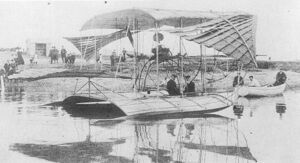Engineering:Humphreys Biplane
| Humphreys Biplane | |
|---|---|

| |
| Role | Biplane flying boat |
| National origin | United Kingdom |
| Designer | Jack Humphreys |
| Introduction | 1909 |
| Number built | 1 |
The Humphreys Biplane was the first serious attempt to build a flying boat in the United Kingdom. Also known as the Wivenhoe Flyer it was designed by dentist Jack Humphreys; it failed to fly.
Design and development
With the help of Forrestt's boatyard, construction by Humphreys of the biplane started in 1908 near Wivenhoe on the River Colne, Essex.[1] With a span of 45 feet it was a sesquiplane biplane with a single-seat hull.[1] The biplane had a 35 hp (26 kW) JAP V8 air-cooled engine which drove two counter-rotating propellers.[1]
The biplane was launched on 3 April 1909 but it turned turtle and sank due to an accident.[1] Recovered and tested again, The Times reported in April 1909 that a further trial was abandoned when the gearing between the engine and the propellers failed.[2] In May 1909 it did manage to skim the water at speed of 12 knots but failed to overcome the drag in the design and failed to fly.[1]
Specifications
Data from London[3]
General characteristics
- Crew: 1
- Length: 38 ft 0 in (11.58 m)
- Wingspan: 45 ft 0 in (13.72 m)
- Wing area: 650 sq ft (60 m2) approximate
- Gross weight: 1,750 lb (794 kg) approximate
- Powerplant: 1 × J.A.P. V8 air-cooled piston engine, 38 hp (28 kW)
References
Notes
Bibliography
- London, Peter (2011). British Flying Boats. The History Press. ISBN 978-0-7524-60550.
 |

